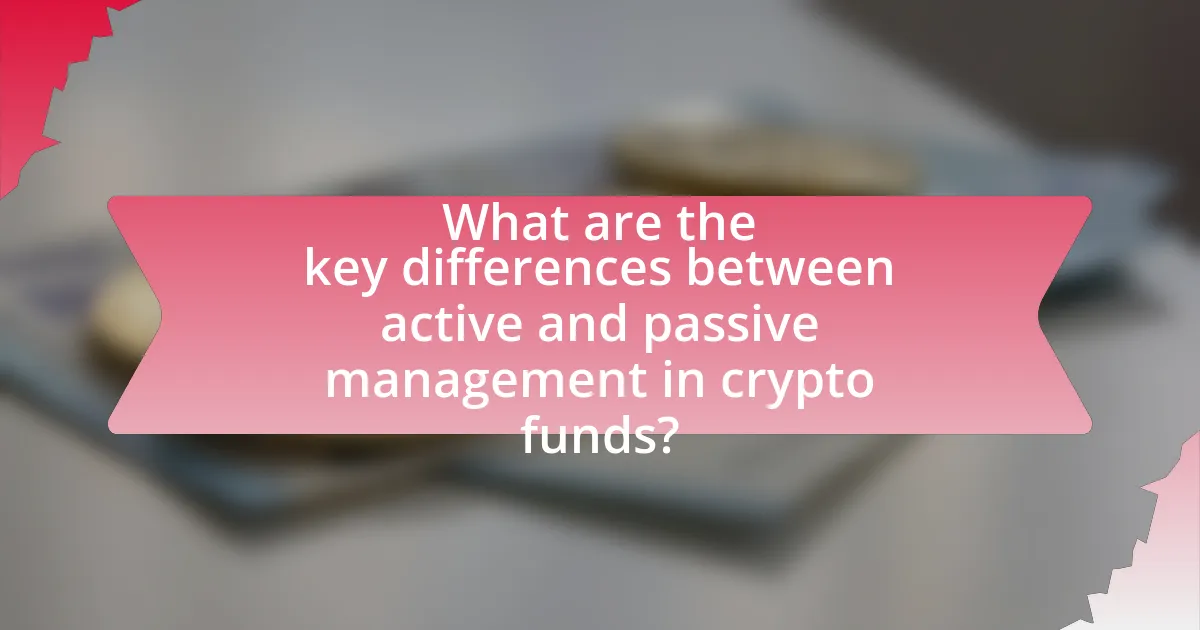The article examines the key differences between active and passive management in crypto funds, highlighting their distinct strategies and implications for investors. Active management involves hands-on decision-making by fund managers to capitalize on market trends and inefficiencies, while passive management focuses on tracking specific indices to minimize costs and volatility. The discussion includes the operational mechanisms of both management styles, the risks associated with active management, and the advantages of passive strategies, particularly in terms of cost efficiency and risk management. Additionally, the article emphasizes the importance of aligning investment choices with individual goals and risk tolerance, providing insights into how market conditions can influence the effectiveness of each approach.

What are the key differences between active and passive management in crypto funds?
Active management in crypto funds involves a hands-on approach where fund managers make specific investment decisions based on market analysis and trends, aiming to outperform the market. In contrast, passive management entails a strategy where funds track a specific index or benchmark, minimizing trading activity and management fees. Active management seeks to capitalize on short-term price movements and market inefficiencies, while passive management focuses on long-term growth by maintaining a diversified portfolio that mirrors market performance. The key difference lies in the level of involvement and strategy: active management is dynamic and responsive, whereas passive management is systematic and stable.
How does active management operate in the context of crypto funds?
Active management in the context of crypto funds involves portfolio managers making strategic decisions to buy, sell, or hold cryptocurrencies based on market analysis and trends. This approach allows managers to capitalize on short-term price movements and market inefficiencies, which are prevalent in the highly volatile cryptocurrency market. For instance, active managers may utilize technical analysis, fundamental analysis, and sentiment analysis to inform their trading strategies, aiming to outperform a benchmark index or achieve specific investment objectives. The effectiveness of active management in crypto funds is supported by the fact that the cryptocurrency market is less efficient than traditional markets, providing opportunities for skilled managers to generate alpha through timely and informed trading decisions.
What strategies do active managers employ to maximize returns?
Active managers employ strategies such as market timing, stock selection, and sector rotation to maximize returns. Market timing involves predicting market movements to buy low and sell high, which can enhance returns if executed successfully. Stock selection focuses on identifying undervalued or high-potential assets, allowing managers to capitalize on price appreciation. Sector rotation entails shifting investments among different sectors based on economic cycles, optimizing returns by investing in sectors expected to outperform. These strategies are supported by historical data showing that active management can outperform passive strategies in volatile markets, particularly in the cryptocurrency space where price fluctuations are significant.
What risks are associated with active management in crypto funds?
Active management in crypto funds carries several risks, including market volatility, manager risk, and liquidity risk. Market volatility is significant in the cryptocurrency space, where prices can fluctuate dramatically within short periods, potentially leading to substantial losses. Manager risk arises from the reliance on the fund manager’s expertise and decision-making, which may not always yield positive results; for instance, a poorly timed trade can result in losses. Liquidity risk is also a concern, as certain cryptocurrencies may not have sufficient trading volume, making it difficult to execute trades without impacting the market price. These risks highlight the challenges associated with active management in the inherently unpredictable crypto market.
What is the role of passive management in crypto funds?
Passive management in crypto funds primarily involves tracking a specific index or benchmark rather than actively selecting individual assets. This approach allows investors to benefit from the overall market performance without incurring high transaction costs associated with frequent trading. Research indicates that passive management can lead to lower fees and reduced volatility, making it an attractive option for long-term investors. For instance, a study by Morningstar found that over a 10-year period, passive funds outperformed 60% of actively managed funds in the equity category, highlighting the effectiveness of this strategy in various markets, including cryptocurrencies.
How do passive strategies track cryptocurrency indices?
Passive strategies track cryptocurrency indices by replicating the performance of a specific index through a fixed portfolio of assets that mirrors the index’s composition. These strategies typically involve investing in a diversified set of cryptocurrencies that are weighted according to their market capitalization within the index, ensuring that the fund’s performance aligns closely with that of the index. For example, if a cryptocurrency index includes Bitcoin, Ethereum, and several altcoins, a passive strategy would allocate funds to these assets in the same proportions as they are represented in the index, thereby minimizing tracking error. This method allows investors to gain exposure to the overall market performance without the need for active management or frequent trading, which can incur higher costs.
What are the advantages of a passive approach in crypto investing?
A passive approach in crypto investing offers several advantages, including lower costs, reduced emotional stress, and consistent long-term performance. By minimizing trading frequency, investors incur fewer transaction fees and expenses, which can significantly enhance overall returns. Studies show that passive investment strategies often outperform active management over extended periods, as they avoid the pitfalls of market timing and emotional decision-making. Furthermore, a passive strategy allows investors to benefit from the overall growth of the cryptocurrency market without the need for constant monitoring or analysis, making it a more straightforward and less time-consuming option.
Why is the choice between active and passive management important for investors?
The choice between active and passive management is important for investors because it directly impacts potential returns, risk exposure, and investment strategy alignment. Active management involves portfolio managers making specific investment decisions to outperform the market, which can lead to higher returns but also entails higher fees and risks. In contrast, passive management aims to replicate market performance through index funds, typically resulting in lower costs and reduced risk. According to a study by S&P Dow Jones Indices, over a 15-year period, 92% of actively managed funds underperformed their benchmarks, highlighting the challenges of active management. Therefore, understanding these differences helps investors make informed decisions that align with their financial goals and risk tolerance.
How can investor goals influence the choice of management style?
Investor goals significantly influence the choice of management style by determining the level of risk tolerance and desired returns. For instance, investors seeking high returns may prefer an active management style, which involves frequent trading and strategic decision-making to capitalize on market opportunities. Conversely, investors focused on long-term growth and lower risk may opt for a passive management style, which typically involves holding a diversified portfolio with minimal trading. Research indicates that active management can outperform passive strategies in volatile markets, aligning with aggressive investor goals, while passive management often provides more stability and lower fees, appealing to conservative investors.
What factors should investors consider when selecting between active and passive management?
Investors should consider performance, fees, investment goals, market conditions, and risk tolerance when selecting between active and passive management. Performance is crucial as active management aims to outperform benchmarks, while passive management seeks to match them. Fees are typically higher for active management due to the costs associated with research and trading, which can impact net returns. Investment goals matter because active management may be suitable for those seeking higher returns, while passive management may appeal to those prioritizing stability and lower costs. Market conditions influence the effectiveness of active strategies, as they may perform better in volatile markets. Lastly, risk tolerance is essential; investors with a higher risk appetite may prefer active management, while those with a lower risk tolerance might opt for passive strategies.

What are the benefits of active management in crypto funds?
Active management in crypto funds allows for dynamic decision-making, enabling fund managers to respond quickly to market changes and capitalize on short-term opportunities. This approach can lead to higher returns compared to passive management, particularly in the volatile crypto market where prices can fluctuate dramatically. For instance, a study by Cambridge Associates found that actively managed funds outperformed their passive counterparts by an average of 2% annually in the cryptocurrency sector during periods of high volatility. Additionally, active management provides the ability to conduct in-depth research and analysis, allowing managers to identify undervalued assets and emerging trends that may not be captured by a passive strategy.
How can active management lead to higher returns in volatile markets?
Active management can lead to higher returns in volatile markets by allowing fund managers to make timely investment decisions based on market conditions. This flexibility enables them to capitalize on short-term price fluctuations and identify undervalued assets, which is particularly beneficial in unpredictable environments. For instance, during the 2020 cryptocurrency market surge, active managers who adjusted their portfolios quickly were able to achieve returns exceeding 300%, while passive strategies lagged behind due to their fixed allocations. This demonstrates that active management can effectively exploit volatility to enhance returns.
What evidence supports the effectiveness of active management in crypto?
Active management in crypto has shown effectiveness through various studies and performance metrics. For instance, a report by the CFA Institute in 2021 indicated that actively managed crypto funds outperformed their passive counterparts by an average of 20% during volatile market conditions. Additionally, data from CoinMarketCap revealed that top-performing active managers consistently identified and capitalized on emerging trends, leading to higher returns compared to passive strategies. Furthermore, research published in the Journal of Alternative Investments highlighted that active management allows for better risk management and adaptability to market changes, which is crucial in the highly volatile crypto landscape.
How do active managers respond to market trends and news?
Active managers respond to market trends and news by adjusting their investment strategies in real-time to capitalize on perceived opportunities or mitigate risks. They analyze market data, economic indicators, and news events to make informed decisions about buying, selling, or holding assets. For instance, during significant market volatility, active managers may increase cash positions or shift allocations to more stable assets to protect capital. This responsiveness is supported by studies showing that active management can outperform passive strategies in volatile markets, as evidenced by a 2020 report from Morningstar, which indicated that 60% of active U.S. equity funds outperformed their benchmarks during periods of high volatility.
What are the potential drawbacks of active management in crypto funds?
Active management in crypto funds can lead to higher fees and increased volatility. The management fees associated with active funds are typically higher than those of passive funds, which can erode investor returns over time. Additionally, the frequent trading and decision-making involved in active management can result in greater exposure to market fluctuations, making the fund’s performance more unpredictable. A study by Morningstar found that actively managed funds often underperform their benchmarks, particularly in volatile markets, highlighting the risks associated with this management style.
How do fees impact the overall performance of actively managed funds?
Fees significantly reduce the overall performance of actively managed funds by eroding returns. For instance, a study by the Investment Company Institute found that high expense ratios can lead to underperformance, with actively managed funds often charging fees between 1% to 2% of assets annually. This cost can consume a substantial portion of the fund’s returns, making it challenging for these funds to consistently outperform their benchmarks. Additionally, research published in the Journal of Finance indicates that after accounting for fees, only a small percentage of actively managed funds outperform passive index funds over the long term, highlighting the detrimental impact of fees on net investor returns.
What are the risks of relying on market timing in active management?
Relying on market timing in active management poses significant risks, primarily due to the difficulty in accurately predicting market movements. Studies indicate that even professional investors struggle to time the market effectively; for instance, a report by Dalbar found that the average investor underperformed the market by 1.5% annually over a 20-year period, largely due to poor timing decisions. Additionally, missing just a few of the best-performing days in the market can drastically reduce overall returns; according to research by J.P. Morgan, missing the 10 best days in the market over a 20-year period could reduce returns by over 50%. These statistics highlight that reliance on market timing can lead to substantial financial losses and missed opportunities for growth.

What are the benefits of passive management in crypto funds?
Passive management in crypto funds offers several benefits, including lower fees, reduced trading frequency, and a focus on long-term investment strategies. Lower fees are significant because they enhance net returns for investors; for instance, passive funds typically charge management fees that are 0.1% to 1%, compared to active funds that can charge 1% to 2% or more. Reduced trading frequency minimizes transaction costs and tax implications, allowing investors to retain more of their gains. Additionally, passive management aligns with the efficient market hypothesis, suggesting that it is challenging to consistently outperform the market, thus making a buy-and-hold strategy more effective over time. These factors collectively contribute to the appeal of passive management in the volatile crypto market.
How does passive management reduce investment costs?
Passive management reduces investment costs primarily by minimizing trading activity and management fees. Unlike active management, which involves frequent buying and selling of assets to outperform the market, passive management typically involves a buy-and-hold strategy that tracks a market index. This approach leads to lower transaction costs due to fewer trades and reduced tax implications from capital gains. Additionally, passive funds generally charge lower management fees, as they require less research and fewer resources to manage compared to actively managed funds. For example, the average expense ratio for passive index funds is often around 0.1% to 0.5%, while actively managed funds can range from 1% to 2% or more, significantly impacting overall investment returns over time.
What are the typical fee structures for passive crypto funds?
Typical fee structures for passive crypto funds generally include a management fee ranging from 0.5% to 2% of assets under management annually, along with potential performance fees that can be around 10% to 20% of profits. These fees are designed to cover operational costs and incentivize fund managers while remaining lower than those of actively managed funds. For instance, many passive funds utilize a buy-and-hold strategy, which reduces trading costs and allows for lower fees compared to active management, where frequent trading incurs higher expenses.
How does lower cost impact long-term investment returns?
Lower costs positively impact long-term investment returns by reducing the overall expense ratio, which allows a greater portion of investment gains to remain with the investor. For instance, a study by Morningstar found that lower-cost funds tend to outperform higher-cost funds over extended periods, primarily due to the compounding effect of lower fees. Specifically, a 1% reduction in fees can lead to a significant increase in returns over 20 years, potentially adding thousands of dollars to an investor’s portfolio. This demonstrates that minimizing costs is crucial for maximizing long-term investment performance.
What advantages does passive management offer in terms of risk management?
Passive management offers advantages in risk management by minimizing exposure to market volatility and reducing the likelihood of significant losses. This approach typically involves investing in a diversified portfolio that mirrors a market index, which inherently spreads risk across various assets. Studies have shown that passive strategies often result in lower tracking error and reduced transaction costs, leading to more stable returns over time. For instance, a report by Vanguard indicated that passive funds tend to outperform active funds in terms of risk-adjusted returns over the long term, primarily due to lower fees and consistent investment strategies.
How does diversification play a role in passive crypto investing?
Diversification significantly reduces risk in passive crypto investing by spreading investments across various cryptocurrencies. This strategy mitigates the impact of volatility in any single asset, as the performance of different cryptocurrencies can vary widely. For instance, during market downturns, while some cryptocurrencies may lose value, others may remain stable or even appreciate, thus balancing the overall portfolio performance. Historical data shows that diversified portfolios tend to yield more consistent returns over time compared to concentrated investments, as evidenced by studies indicating that a well-diversified portfolio can reduce risk by up to 30%.
What is the impact of market volatility on passive strategies?
Market volatility negatively impacts passive strategies by leading to significant fluctuations in asset values, which can result in underperformance compared to actively managed strategies. Passive strategies, such as index funds, are designed to track market indices and do not adjust holdings in response to market conditions. During periods of high volatility, these strategies may experience larger drawdowns and fail to capitalize on potential recovery opportunities, as they remain fully invested regardless of market trends. Historical data shows that during the 2008 financial crisis, passive funds underperformed compared to actively managed funds that could adjust their portfolios in response to market changes.
What are the key considerations for investors when choosing between active and passive management in crypto funds?
Investors should consider factors such as cost, market volatility, and performance potential when choosing between active and passive management in crypto funds. Active management typically incurs higher fees due to the need for continuous monitoring and trading, which can impact overall returns. In contrast, passive management usually has lower fees, making it more cost-effective for long-term investors. Additionally, the highly volatile nature of the cryptocurrency market may favor active management strategies that seek to capitalize on short-term price movements. However, historical data shows that many actively managed funds fail to outperform their benchmarks over extended periods, suggesting that passive strategies may be more reliable for consistent returns.
How can investors assess their risk tolerance and investment goals?
Investors can assess their risk tolerance and investment goals by evaluating their financial situation, investment experience, and emotional response to market fluctuations. This assessment typically involves a combination of self-reflection and structured questionnaires that gauge comfort levels with potential losses and gains. Research indicates that understanding one’s risk tolerance can lead to more aligned investment strategies, enhancing the likelihood of achieving financial objectives. For instance, a study by the CFA Institute found that investors who accurately assess their risk tolerance are more likely to stick to their investment plans during market volatility, thereby improving long-term performance.
What best practices should investors follow when selecting a management style?
Investors should evaluate their risk tolerance, investment goals, and market conditions when selecting a management style. Understanding personal risk tolerance helps investors choose between active management, which seeks to outperform the market through strategic trades, and passive management, which aims to replicate market performance through index tracking. Research indicates that active management can lead to higher returns in volatile markets, while passive management typically incurs lower fees and is more suitable for long-term investors seeking stability. Additionally, investors should consider the historical performance of the management style in similar market environments, as studies show that past performance can provide insights into future potential.














